Retro #3 – PS1 theme by DriveForSix
Download: Retro3PS1.p3t

(1 background)
Redirect to:
This page is a redirect. The following categories are used to track and monitor this redirect:
|

The #1 spot for Playstation themes!
Retro #3 – PS1 theme by DriveForSix
Download: Retro3PS1.p3t

(1 background)
Redirect to:
This page is a redirect. The following categories are used to track and monitor this redirect:
|
Icy theme by Ryan Graves
Download: Icy.p3t

(5 backgrounds)
Icy commonly refers to conditions involving ice, a frozen state, usually referring to frozen water.
Icy or Icey may also refer to:
Horror Movies theme by DDC
Download: HorrorMovies.p3t
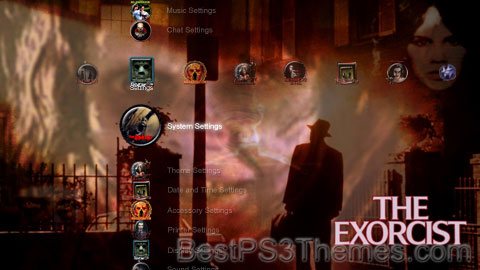
(9 backgrounds)
P3T Unpacker v0.12
Copyright (c) 2007. Anoop Menon
This program unpacks Playstation 3 Theme files (.p3t) so that you can touch-up an existing theme to your likings or use a certain wallpaper from it (as many themes have multiple). But remember, if you use content from another theme and release it, be sure to give credit!
Download for Windows: p3textractor.zip
Instructions:
Download p3textractor.zip from above. Extract the files to a folder with a program such as WinZip or WinRAR. Now there are multiple ways to extract the theme.
The first way is to simply open the p3t file with p3textractor.exe. If you don’t know how to do this, right click the p3t file and select Open With. Alternatively, open the p3t file and it will ask you to select a program to open with. Click Browse and find p3textractor.exe from where you previously extracted it to. It will open CMD and extract the theme to extracted.[filename]. After that, all you need to do for any future p3t files is open them and it will extract.
The second way is very simple. Just drag the p3t file to p3textractor.exe. It will open CMD and extract the theme to extracted.[filename].
For the third way, first put the p3t file you want to extract into the same folder as p3textractor.exe. Open CMD and browse to the folder with p3extractor.exe. Enter the following:
p3textractor filename.p3t [destination path]Replace filename with the name of the p3t file, and replace [destination path] with the name of the folder you want the files to be extracted to. A destination path is not required. By default it will extract to extracted.filename.
The Dark Knight Returns theme by ZHero
Download: DarkKnightReturns.p3t
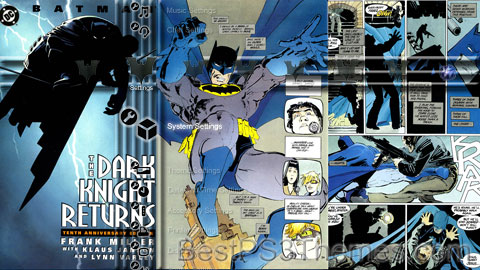
(6 backgrounds)
This article needs additional citations for verification. (February 2024) |
| Batman: The Dark Knight Returns | |
|---|---|
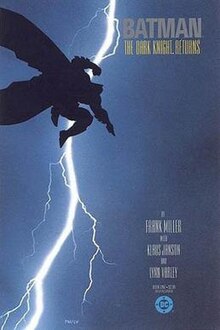 Cover of Issue #1 | |
| Publication information | |
| Publisher | DC Comics |
| Schedule | Monthly |
| Format | Limited series |
| Publication date | February – June 1986 |
| No. of issues | 4 |
| Main character(s) | |
| Creative team | |
| Written by | Frank Miller |
| Penciller(s) | Frank Miller |
| Inker(s) | Klaus Janson |
| Letterer(s) | John Costanza |
| Colorist(s) | Lynn Varley |
| Editor(s) | Dick Giordano Dennis O'Neil |
| Collected editions | |
| Trade Paperback | ISBN 0930289137 |
| Hardcover | ISBN 0930289153 |
| Trade Paperback (Warner Books) | ISBN 0446385050 |
| Trade Paperback (Titan Books) | ISBN 0907610900 |
| 10th Anniversary Edition | ISBN 156389341X |
| 2002 Edition | ISBN 156389341X |
| Absolute Edition | ISBN 1401210791 |
| Noir | ISBN 1401255140 |
| Deluxe Edition | ISBN 1401256910 |
| 30th Anniversary Edition | ISBN 1401263119 |
| Book with Blu-ray & DVD set | ISBN 1401264271 |
| Gallery Edition | ISBN 1401264433 |
| Collector's Edition | ISBN 1401270131 |
The Dark Knight Returns (alternatively titled Batman: The Dark Knight Returns) is a 1986 four-issue comic book miniseries starring Batman, written by Frank Miller, illustrated by Miller and Klaus Janson, with color by Lynn Varley, and published by DC Comics. It tells an alternative story of Bruce Wayne, who at 55 years old returns from a decade of retirement to fight crime while facing opposition from the Gotham City police force and the United States government. The story also features the return of classic foes Two-Face and the Joker, and culminates in a confrontation with Superman, who is now a pawn of the government.
When originally published, the series was simply titled Batman: The Dark Knight, with a different title for each issue (The Dark Knight Returns, The Dark Knight Triumphant, Hunt the Dark Knight, and The Dark Knight Falls), but when the series was collected into a single volume, the title of the first issue was applied to the entire series. Some of the earliest collected editions also bore the shorter series title. The story introduces Carrie Kelley as the new Robin and the hyper-violent street gang known as the Mutants. In the Pre-Flashpoint DC Multiverse, the events of The Dark Knight Returns and its associated titles were designated to occur on Earth-31.[1]
The miniseries has since been followed by a number of sequels: The Dark Knight Strikes Again, The Dark Knight III: The Master Race, and Dark Knight Returns: The Golden Child. A one-shot prequel, Dark Knight Returns: The Last Crusade, takes place ten years before the original series. Both Batman: Year One and All Star Batman & Robin, the Boy Wonder, are considered by Miller to be canon. Likewise, Superman: Year One takes place in the Dark Knight universe.
The Dark Knight Returns is widely considered to be one of the greatest and most influential Batman stories ever made, as well as one of the greatest works of comic art in general, and has been noted for helping reintroduce a darker and more mature-oriented version of the character (and superheroes in general) to pop culture during the 1980s. Various elements of the series have since been incorporated into depictions of Batman in other media, while a direct animated adaptation of the story, Batman: The Dark Knight Returns, was released as a two-part film across 2012 and 2013.
The Dark Knight Returns is set in a dystopian version of Gotham City in 1986. Bruce Wayne, aged 55,[2] has given up the mantle of Batman after the death of Jason Todd ten years prior. Crime is running rampant throughout the city and a teenage gang calling themselves "The Mutants" has begun terrorizing the people of Gotham. After watching news reports about the Mutants' crimes, Wayne decides to return to his role as a vigilante. On his first night as Batman, he stops multiple assaults – including one on two young girls, Carrie Kelley and her friend Michelle – and targets the Mutants.
While foiling an armed robbery, Batman learns that the criminals are working for Harvey Dent. Previously known as Two-Face, Dent underwent extensive therapy and plastic surgery to reenter society before disappearing. Batman informs close to retirement Commissioner James "Jim" Gordon that Dent may be planning a larger scheme. Soon after, Dent announces his intention to hold Gotham ransom with a bomb. After Batman defeats Dent and his goons, he discovers that Dent's mind has completely warped into his Two-Face persona.
Inspired by Batman, Kelley buys an imitation Robin costume and searches for him. Batman attacks the Mutants at the city dump with the Batmobile, but the Mutant Leader goads him into a hand-to-hand fight. Batman, due to his age and a decade of physical inactivity, is beaten and almost killed. Kelley creates a diversion that allows her and Batman to return to the Batcave, where Wayne's butler Alfred Pennyworth tends to his wounds. Impressed with her bravery, Wayne decides to make Kelley his new protegee. Batman strategically defeats the Mutant Leader in a fight surrounded by the Mutants. Seeing Batman defeat their leader, most of the Mutants disband into smaller gangs. One of these gangs renames itself the "Sons of the Batman", using excessive violence against criminals.
At the White House, Superman and current President Ronald Reagan discuss the events in Gotham, with the latter suggesting that Batman may have to be arrested. Clark Kent talks with Wayne and is then deployed by Washington to the Latin American country of Corto Maltese, where he fights Soviet combat forces in a conflict that may escalate into World War III.
Gordon's successor as commissioner, Captain Ellen Yindel, declares Batman a wanted criminal for his vigilante activities. Batman's return stimulates his archenemy, Joker, to awaken from catatonia at Arkham Asylum. Joker manipulates his caretakers to allow him onto a television talk show, where he murders everyone with Joker venom and escapes. Batman and Robin (Kelley) track him to a county fair while evading a Gotham police pursuit. Batman fights Joker, vowing to stop him permanently, feeling responsible for every murder the villain has committed. Batman paralyzes the Joker but is unable to take his life. Disappointed with Batman's refusal to kill him, Joker breaks his own neck and dies.
A citywide manhunt for Batman begins. Elsewhere, Superman diverts a Soviet nuclear warhead which detonates in a desert, nearly killing him in the process, and survives only by absorbing the sun's energy from the plants in a nearby jungle. The United States is hit by an electromagnetic pulse as a result and descends into chaos during the following blackout. In Gotham, Batman and Robin turn the remaining Mutants and Sons of the Batman into a non-lethal vigilante gang, making Gotham the safest city in the country. The U.S. government orders Superman to take Batman into custody. Superman demands to meet Batman, and Wayne chooses Crime Alley.
Superman tries to reason with Batman, but Batman uses his technological inventions to fight him on equal ground. During the battle, Superman compromises Batman's exoframe. However, an aging Oliver Queen manages to shoot Superman with a kryptonite-tipped arrow to weaken him. Standing over the defeated Superman, Batman has a sudden heart attack, apparently dying. Alfred destroys the Batcave and Wayne Manor before suffering a fatal stroke, exposing Batman as Bruce Wayne, whose fortune has disappeared. After Wayne's funeral, it is revealed that his death was staged using a chemical that suspended his vital life signs. Clark attends the funeral and winks at the disguised Carrie after hearing Wayne's heartbeat. Some time afterward, Bruce Wayne leads Robin, Queen, and the rest of his followers into the caverns beyond the Batcave and prepares to continue his war on crime.

Since the 1950s, when the Comics Code Authority was established, the character of Batman had drifted from his darker, more serious roots. It was not until the 1970s when the character began to feature in darker stories once again; however, Batman was still commonly associated with the campy theme of the 1960s Batman TV series, and was regarded more as a father figure to Robin rather than as his original identity as a vigilante.[3]
In the early 1980s, DC Comics promoted Batman group editor Dick Giordano to editorial director for the company.[4] Writer-artist Frank Miller was recruited to create The Dark Knight Returns. Giordano said he worked with Miller on the story's plot, and said, "[t]he version that was finally done was about his fourth or fifth draft. The basic storyline was the same but there were a lot of detours along the way."[5]
"With Batman, you've got a character that you can describe in just a few seconds: His parents were murdered by criminals; he's warring on crime for the rest of his life," Miller explained in the documentary Comic Book Confidential. "He was created in 1938, and the character was just ruthless in his methods, terrifying to criminals. Over the years, that got softened and softened, because people started thinking that comics had to be just for kids... and Batman had to be made much nicer. And eventually, no kid could relate to him anymore."[6]
During the creation of the series, fellow comics writer/artist John Byrne told Miller, "Robin must be a girl", and Miller agreed.[7] Miller said that the comic series' plot was inspired by Dirty Harry, specifically the 1983 film Sudden Impact, in which Dirty Harry returns to crime-fighting after a lengthy convalescence.[citation needed] The series employed a 16-panel grid for its pages. Each page was composed of either a combination of 16 panels, or anywhere between sixteen and one panel per page.[8] Giordano left the project halfway through because of disagreements over production deadlines. Comics historian Les Daniels wrote that Miller's idea of ignoring deadlines was "the culmination of the quest towards artistic independence".[9]
While the comic's ending features Batman faking his death and leading up the Sons of Batman to continue with his crusade against crime, symbolizing that Bruce Wayne dies but Batman lives on, this wasn't the original intention. During the MCM London Comic Con 2018, Miller revealed that in his original plans for the ending of The Dark Knight Returns, Batman was going to be gunned down by the police while fighting them, but the story got away from him and changed his mind.[10]
The issues of The Dark Knight Returns were presented in packaging that included extra pages, square binding, and glossy paper to highlight the watercolor paintings by colorist Lynn Varley.[11]
The entire series has been collected in trade paperbacks, hardcovers, an absolute edition, a noir edition, and a deluxe edition.
Despite the cost of the single-issue packaging, The Dark Knight Returns sold well.[11] Pricing it at $2.95 an issue, DC Comics promoted The Dark Knight Returns as a "thought-provoking action story". Time said the series' depiction of a "semi-retired Batman [who] is unsure about his crime-fighting abilities" was an example of trying to appeal to "today's skeptical readers".[12] More than one million comics were printed.[13]
Retrospectively, the series is today widely considered one of the greatest works in the comic medium. IGN Comics ranked The Dark Knight Returns first on a list of the 25 greatest Batman graphic novels and called The Dark Knight Returns "a true masterpiece of storytelling" with "[s]cene after unforgettable scene."[14] In 2005, Time chose the collected edition as one of the 10 best English language graphic novels ever written.[15] Forbidden Planet placed the collected issue at number one on its "50 Best of the Best Graphic Novels" list.[16] Writer Matthew K. Manning in the "1980s" chapter of DC Comics Year By Year A Visual Chronicle (2010) called the series "arguably the best Batman story of all time."[3] It was placed second in a poll among comic book academics conducted by the Sequart Organization.[17]
The series also garnered some negative reviews. In April 2010, Nicolas Slayton from Comics Bulletin ranked The Dark Knight Returns second in his Tuesday Top Ten feature's Top 10 Overrated Comic Books behind Watchmen. Slayton wrote, "[t]here is no central plot to the comic, leaving only a forced fight scene between Superman and Batman as an out of place climax to the story." "Gone are the traits that define Batman," he said, also citing "misuse of the central character."[18]

The immense popularity of The Dark Knight Returns served both to return the character of Batman to a central role in pop culture, but also (along with Watchmen) started the era known as the Dark Age of Comic Books (also known as the Modern Age and the Iron Age).[19] The grim, seedy versions of Gotham and Batman updated the character's identity from the campy Adam West version from the 1960s Batman TV series, and proved critically and commercially successful enough that a new wave of "dark" superheroes were either created or re-popularized, and preexisting heroes were redesigned or retooled to fit this new trend.[citation needed]
The Dark Knight Returns was one of the two comic books, alongside Watchmen, that inspired designer Vincent Connare when he created the Comic Sans font.[20]
Tomb Raider Underground – Lara theme by DaftMav
Download: TRUndergroundLara.p3t

(4 backgrounds)
P3T Unpacker v0.12
Copyright (c) 2007. Anoop Menon
This program unpacks Playstation 3 Theme files (.p3t) so that you can touch-up an existing theme to your likings or use a certain wallpaper from it (as many themes have multiple). But remember, if you use content from another theme and release it, be sure to give credit!
Download for Windows: p3textractor.zip
Instructions:
Download p3textractor.zip from above. Extract the files to a folder with a program such as WinZip or WinRAR. Now there are multiple ways to extract the theme.
The first way is to simply open the p3t file with p3textractor.exe. If you don’t know how to do this, right click the p3t file and select Open With. Alternatively, open the p3t file and it will ask you to select a program to open with. Click Browse and find p3textractor.exe from where you previously extracted it to. It will open CMD and extract the theme to extracted.[filename]. After that, all you need to do for any future p3t files is open them and it will extract.
The second way is very simple. Just drag the p3t file to p3textractor.exe. It will open CMD and extract the theme to extracted.[filename].
For the third way, first put the p3t file you want to extract into the same folder as p3textractor.exe. Open CMD and browse to the folder with p3extractor.exe. Enter the following:
p3textractor filename.p3t [destination path]Replace filename with the name of the p3t file, and replace [destination path] with the name of the folder you want the files to be extracted to. A destination path is not required. By default it will extract to extracted.filename.
Tiger-4 theme by Luvsanimals07
Download: Tiger-4.p3t

(4 backgrounds)
P3T Unpacker v0.12
Copyright (c) 2007. Anoop Menon
This program unpacks Playstation 3 Theme files (.p3t) so that you can touch-up an existing theme to your likings or use a certain wallpaper from it (as many themes have multiple). But remember, if you use content from another theme and release it, be sure to give credit!
Download for Windows: p3textractor.zip
Instructions:
Download p3textractor.zip from above. Extract the files to a folder with a program such as WinZip or WinRAR. Now there are multiple ways to extract the theme.
The first way is to simply open the p3t file with p3textractor.exe. If you don’t know how to do this, right click the p3t file and select Open With. Alternatively, open the p3t file and it will ask you to select a program to open with. Click Browse and find p3textractor.exe from where you previously extracted it to. It will open CMD and extract the theme to extracted.[filename]. After that, all you need to do for any future p3t files is open them and it will extract.
The second way is very simple. Just drag the p3t file to p3textractor.exe. It will open CMD and extract the theme to extracted.[filename].
For the third way, first put the p3t file you want to extract into the same folder as p3textractor.exe. Open CMD and browse to the folder with p3extractor.exe. Enter the following:
p3textractor filename.p3t [destination path]Replace filename with the name of the p3t file, and replace [destination path] with the name of the folder you want the files to be extracted to. A destination path is not required. By default it will extract to extracted.filename.
Rock theme by DDC
Download: Rock.p3t

(8 backgrounds)
Rock most often refers to:
Rock or Rocks may also refer to:
The Simpsons theme by Alfie
Download: Simpsons_9.p3t
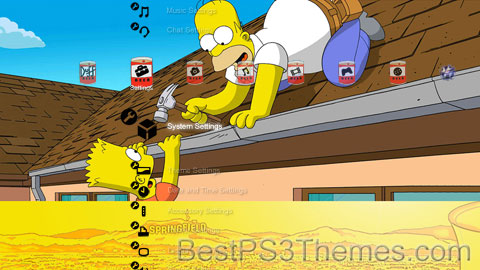
(1 background)
| The Simpsons | |
|---|---|
 | |
| Genre | |
| Created by | Matt Groening |
| Based on | The Simpsons shorts by Matt Groening |
| Developed by |
|
| Showrunners |
|
| Voices of | |
| Theme music composer | Danny Elfman |
| Opening theme | "The Simpsons Theme" |
| Ending theme | "The Simpsons Theme" (reprise) |
| Composers | Richard Gibbs (1989–1990) Alf Clausen (1990–2017) Bleeding Fingers Music (2017–present) |
| Country of origin | United States |
| Original language | English |
| No. of seasons | 35 |
| No. of episodes | 768 (list of episodes) |
| Production | |
| Executive producers | List
|
| Producers |
|
| Editors |
|
| Running time | 21–24 minutes |
| Production companies |
|
| Original release | |
| Network | Fox |
| Release | December 17, 1989 – present |
The Simpsons is an American animated sitcom created by Matt Groening for the Fox Broadcasting Company.[1][2][3] Developed by Groening, James L. Brooks, and Sam Simon, the series is a satirical depiction of American life, epitomized by the Simpson family, which consists of Homer, Marge, Bart, Lisa, and Maggie. Set in the fictional town of Springfield, it caricatures society, Western culture, television, and the human condition.
The family was conceived by Groening shortly before a solicitation for a series of animated shorts with producer Brooks. He created a dysfunctional family and named the characters after his own family members, substituting Bart for his own name; he thought Simpson was a funny name in that it sounded similar to "simpleton".[4] The shorts became a part of The Tracey Ullman Show on April 19, 1987. After three seasons, the sketch was developed into a half-hour prime time show and became Fox's first series to land in the Top 30 ratings in a season (1989–1990).
Since its debut on December 17, 1989, 768 episodes of the show have been broadcast. It is the longest-running American animated series, longest-running American sitcom, and the longest-running American scripted primetime television series, both in seasons and individual episodes. A feature-length film, The Simpsons Movie, was released in theaters worldwide on July 27, 2007, to critical and commercial success, with a sequel in development as of 2018. The series has also spawned numerous comic book series, video games, books, and other related media, as well as a billion-dollar merchandising industry. The Simpsons is a joint production by Gracie Films and 20th Television.[5]
On January 26, 2023, the series was renewed for its 35th and 36th seasons, taking the show through the 2024–25 television season.[6] Both seasons contain a combined total of 51 episodes. Seven of these episodes are season 34 holdovers, while the other 44 will be produced in the production cycle of the upcoming seasons, bringing the show's overall episode total up to 801.[7] Season 35 premiered on October 1, 2023.[8]
The Simpsons received widespread acclaim throughout its early seasons in the 1990s, which are generally considered its "golden age". Since then, it has been criticized for a perceived decline in quality. Time named it the 20th century's best television series,[9] and Erik Adams of The A.V. Club named it "television's crowning achievement regardless of format".[10] On January 14, 2000, the Simpson family was awarded a star on the Hollywood Walk of Fame. It has won dozens of awards since it debuted as a series, including 37 Primetime Emmy Awards, 34 Annie Awards, and 2 Peabody Awards. Homer's exclamatory catchphrase of "D'oh!" has been adopted into the English language, while The Simpsons has influenced many other later adult-oriented animated sitcom television series.
The main characters are the Simpson family, who live in the fictional "Middle America" town of Springfield.[11] Homer, the father, works as a safety inspector at the Springfield Nuclear Power Plant, a position at odds with his careless, buffoonish personality. He is married to Marge (née Bouvier), a stereotypical American housewife and mother. They have three children: Bart, a ten-year-old troublemaker and prankster; Lisa, a precocious eight-year-old activist; and Maggie, the baby of the family who rarely speaks, but communicates by sucking on a pacifier. Although the family is dysfunctional, many episodes examine their relationships and bonds with each other and they are often shown to care about one another.[12]
The family also owns a greyhound, Santa's Little Helper, (who first appeared in the episode "Simpsons Roasting on an Open Fire" and a cat, Snowball II, who is replaced by a cat also called Snowball II in the fifteenth-season episode "I, (Annoyed Grunt)-Bot".[13] Extended members of the Simpson and Bouvier family in the main cast include Homer's father Abe and Marge's sisters Patty and Selma. Marge's mother Jacqueline and Homer's mother Mona appear less frequently.
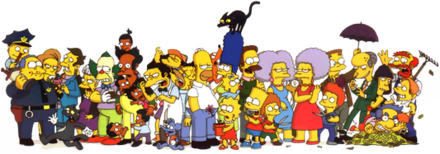
The show includes a vast array of quirky supporting characters, which include Homer's friends Barney Gumble, Lenny Leonard and Carl Carlson; the school principal Seymour Skinner and staff members such as Edna Krabappel and Groundskeeper Willie; students such as Milhouse Van Houten, Nelson Muntz and Ralph Wiggum; shopkeepers such as Apu Nahasapeemapetilon, Comic Book Guy and Moe Szyslak; government figures Mayor "Diamond" Joe Quimby and Clancy Wiggum; next-door neighbor Ned Flanders; local celebrities such as Krusty the Clown and news reporter Kent Brockman; nuclear tycoon Montgomery Burns and his devoted assistant Waylon Smithers; and dozens more.
The creators originally intended many of these characters as one-time jokes or for fulfilling needed functions in the town. A number of them have gained expanded roles and subsequently starred in their own episodes. According to Matt Groening, the show adopted the concept of a large supporting cast from the comedy show SCTV.[14]
Despite the depiction of yearly milestones such as holidays or birthdays passing, the characters never age. The series uses a floating timeline in which episodes generally take place in the year the episode is produced. Flashbacks and flashforwards do occasionally depict the characters at other points in their lives, with the timeline of these depictions also generally floating relative to the year the episode is produced. For example, the 1991 episodes "The Way We Was" and "I Married Marge" depict Homer and Marge as high schoolers in the 1970s who had Bart (who is always 10 years old) in the early '80s, while the 2008 episode "That '90s Show" depicts Homer and Marge as a childless couple in the '90s, and the 2021 episode "Do Pizza Bots Dream of Electric Guitars" portrays Homer as an adolescent in the same period. The 1995 episode "Lisa's Wedding" takes place during Lisa's college years in the then-future year of 2010, the same year the show began airing its 22nd season, in which Lisa was still 8. Regarding the contradictory flashbacks, Selman stated that "they all kind of happened in their imaginary world."[15]
The show follows a loose and inconsistent continuity. For example, Krusty the Clown may be able to read in one episode, but not in another. However, it is consistently portrayed that he is Jewish, that his father was a rabbi, and that his career began in the 1960s. The latter point introduces another snag in the floating timeline: historical periods that are a core part of a character's backstory remain so even when their age makes it unlikely or impossible, such as Grampa Simpson and Principal Skinner's respective service in World War II and Vietnam.
The only episodes not part of the series' main canon are the Treehouse of Horror episodes, which often feature the deaths of main characters. Characters who die in "regular" episodes, such as Maude Flanders, Mona Simpson and Edna Krabappel, however, stay dead. Most episodes end with the status quo being restored, though occasionally major changes will stick, such as Lisa's conversions to vegetarianism and Buddhism, the divorce of Milhouse van Houten's parents, and the marriage and subsequent parenthood of Apu and Manjula.
The Simpsons takes place in a fictional American town called Springfield. Although there are many real settlements in America named Springfield,[16] the town the show is set in is fictional. The state it is in is not established. In fact, the show is intentionally evasive with regard to Springfield's location.[17] Springfield's geography and that of its surroundings is inconsistent: from one episode to another, it may have coastlines, deserts, vast farmland, mountains, or whatever the story or joke requires.[18] Groening has said that Springfield has much in common with Portland, Oregon, the city where he grew up.[19] Groening has said that he named it after Springfield, Oregon, and the fictitious Springfield which was the setting of the series Father Knows Best. He "figured out that Springfield was one of the most common names for a city in the U.S. In anticipation of the success of the show, I thought, 'This will be cool; everyone will think it's their Springfield.' And they do."[20] Many landmarks, including street names, have connections to Portland.[21]
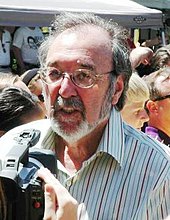
When producer James L. Brooks was working on the television variety show The Tracey Ullman Show, he decided to include small animated sketches before and after the commercial breaks. Having seen one of cartoonist Matt Groening's Life in Hell comic strips, Brooks asked Groening to pitch an idea for a series of animated shorts. Groening initially intended to present an animated version of his Life in Hell series.[22] However, Groening later realized that animating Life in Hell would require the rescinding of publication rights for his life's work. He therefore chose another approach while waiting in the lobby of Brooks's office for the pitch meeting, hurriedly formulating his version of a dysfunctional family that became the Simpsons.[22][23] He named the characters after his own family members, substituting "Bart" for his own name, adopting an anagram of the word brat.[22]
The Simpson family first appeared as shorts in The Tracey Ullman Show on April 19, 1987.[24] Groening submitted only basic sketches to the animators and assumed that the figures would be cleaned up in production. However, the animators merely re-traced his drawings, which led to the crude appearance of the characters in the initial shorts.[22] The animation was produced domestically at Klasky Csupo,[25][26] with Wes Archer, David Silverman, and Bill Kopp being animators for the first season.[27] The colorist, "Georgie" Gyorgyi Kovacs Peluce (Kovács Györgyike)[28][29][30][31][32][33] made the characters yellow; as Bart, Lisa and Maggie have no hairlines, she felt they would look strange if they were flesh-colored. Groening supported the decision, saying: "Marge is yellow with blue hair? That's hilarious — let's do it!"[27]
In 1989, a team of production companies adapted The Simpsons into a half-hour series for the Fox Broadcasting Company. The team included the Klasky Csupo animation house. Brooks negotiated a provision in the contract with the Fox network that prevented Fox from interfering with the show's content.[34] Groening said his goal in creating the show was to offer the audience an alternative to what he called "the mainstream trash" that they were watching.[35] The half-hour series premiered on December 17, 1989, with "Simpsons Roasting on an Open Fire".[36] "Some Enchanted Evening" was the first full-length episode produced, but it did not broadcast until May 1990, as the last episode of the first season, because of animation problems.[37] In 1992, Tracey Ullman filed a lawsuit against Fox, claiming that her show was the source of the series' success. The suit said she should receive a share of the profits of The Simpsons[38]—a claim rejected by the courts.[39]

List of showrunners throughout the series' run:
Matt Groening and James L. Brooks have served as executive producers during the show's entire history, and also function as creative consultants. Sam Simon, described by former Simpsons director Brad Bird as "the unsung hero" of the show,[40] served as creative supervisor for the first four seasons. He was constantly at odds with Groening, Brooks and the show's production company Gracie Films and left in 1993.[41] Before leaving, he negotiated a deal that sees him receive a share of the profits every year, and an executive producer credit despite not having worked on the show since 1993,[41][42] at least until his passing in 2015.[43] A more involved position on the show is the showrunner, who acts as head writer and manages the show's production for an entire season.[27]
The first team of writers, assembled by Sam Simon, consisted of John Swartzwelder, Jon Vitti, George Meyer, Jeff Martin, Al Jean, Mike Reiss, Jay Kogen and Wallace Wolodarsky.[44] Newer Simpsons' writing teams typically consist of sixteen writers who propose episode ideas at the beginning of each December.[45] The main writer of each episode writes the first draft. Group rewriting sessions develop final scripts by adding or removing jokes, inserting scenes, and calling for re-readings of lines by the show's vocal performers.[46] Until 2004,[47] George Meyer, who had developed the show since the first season, was active in these sessions. According to long-time writer Jon Vitti, Meyer usually invented the best lines in a given episode, even though other writers may receive script credits.[46] Each episode takes six months to produce so the show rarely comments on current events.[48]
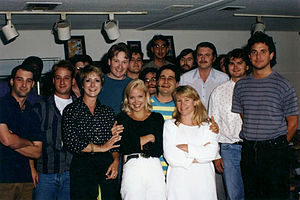
Credited with sixty episodes, John Swartzwelder is the most prolific writer on The Simpsons.[49] One of the best-known former writers is Conan O'Brien, who contributed to several episodes in the early 1990s before replacing David Letterman as host of the talk show Late Night.[50] English comedian Ricky Gervais wrote the episode "Homer Simpson, This Is Your Wife", becoming the first celebrity both to write and guest star in the same episode.[51] Seth Rogen and Evan Goldberg, writers of the film Superbad, wrote the episode "Homer the Whopper", with Rogen voicing a character in it.[52]
At the end of 2007, the writers of The Simpsons went on strike together with the other members of the Writers Guild of America, East. The show's writers had joined the guild in 1998.[53]
In May 2023, the writers of The Simpsons went on strike together with the other members of the Writers Guild of America, East.[54][55]